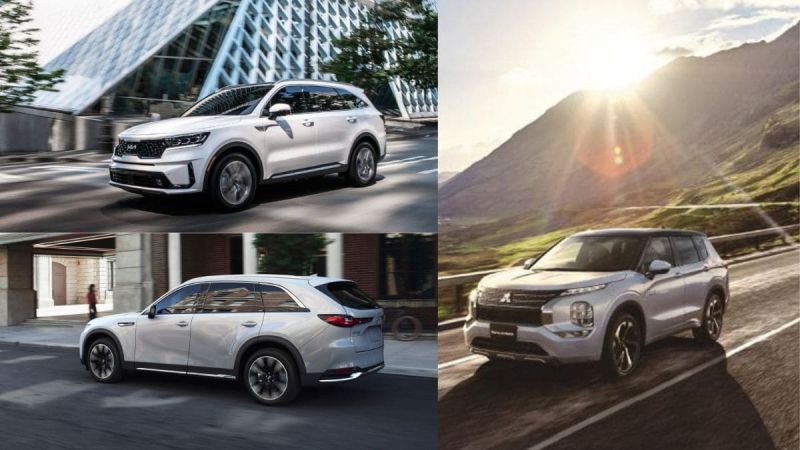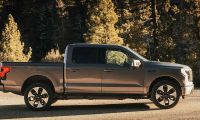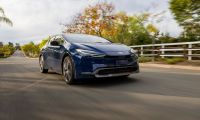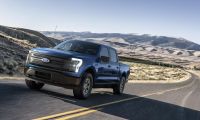The list of 3-row PHEV SUVs on sale in the US for 2023 isn’t that long, but it includes models from: Kia (the Sorento PHEV), Mazda (forthcoming CX-90 PHEV), Mitsubishi (Outlander PHEV), Lincoln (Aviator Grand Touring PHEV), Range Rover (P440e AWD PHEV) and Volvo (XC90 Recharge).
Half of these PHEV SUVs are luxury vehicles whose prices are about $70k and up (the Lincoln having the lowest starting price at just under $70k, the Range Rover in the low 6 digit range).
The luxury price points are a bit higher than the mainstream options, as you might expect. The mainstream models have base MSRPs starting in the $40k (Mitsubishi) to $50k and up range. I will only mention the luxury versions briefly and focus more coverage on the mainstream options since fewer people will be shopping for the spendier models. I’ll point out that of all the PHEV SUVs, in base model specs, the Range Rover has the largest battery (38.2 kWh) and longest EV only range (50+ miles), the Lincoln has the shortest EV only range (21 miles) and the Volvo has the most horsepower (455 max combined) and torque (523 lb. ft). Note that at least a couple of these PHEVs haven’t gone on sale yet but all will be available sometime this year.
Lets focus on the mainstream options starting with the lowest, base model price point, according to the MSRP. The Mitsubishi Outlander PHEV, with a starting price of $39,845, is by far the lowest priced 3 row PHEV currently on sale in the US. It is capable and well appointed, has the largest battery capacity of the 3 mainstream PHEVs (at 20 kWh) and likely the greatest range in battery only mode (at 38 miles). I say “likely” because the specs for the Mazda are still TBD, but it would likely not have more than low to mid 30’s battery only range (though one publication estimates only 20-25 miles of battery only range).
My estimate, based purely on the size of the Mazda’s battery (17.8 kWh) and weight of around 5,000 lbs, is 33 miles of range, but that is simply a guess.
The Kia Sorento PHEV is rated for 32 miles of battery only range, though I have pushed it to 41 miles by driving gently. Returning to the Mitsubishi, I’ll point out that it is the smallest PHEV in this list and really is more of a compact SUV size that manages to squeeze in a 3rd row. Thus, if you truly need the capability or capacity of a 3 row SUV, the Mitsubishi probably isn’t the best choice as either the Kia or Mazda offer significantly more space inside.
The Mazda is the largest, most capacious option of the mainstream SUVs by a healthy margin at almost a foot longer, around 3 inches wider - not counting wheel well arches - and almost 2 inches taller than the Kia. Not only is the Mazda the largest of the 3 mainstream SUV PHEVs, it is the only one in the US that will come with seating for up to 8 (depending on trim).
The Mazda also offers the option of 2nd row captains chairs to more easily reach the 3rd row bench which seats 3, whereas the Mitsubishi only has a 2nd row bench, and the Kia only offers seating for 6 (with captains chairs in the 2nd row). One place the Kia outshines the other mainstream PHEVs is in its gas powered fuel efficiency where it is rated for 34 MPG. The Mazda is expected to have a combined 25 MPG rating according to Car and Driver.
The Mazda should also have the shortest battery recharge times of the mainstream options since it can charge at 7.4 kW compared to the Kia and Mitsubishi which can only charge at a maximum of around 3.7 kW. I would estimate that means the Mazda can recharge a depleted drive battery in around 2 hours (a little over I would expect) compared to about 3.5 - 4 hours for the Kia and around 6.5 hours for the Mitsubishi on the faster 240V service each can support. Note that the Mitsubishi can also charge on faster 480V equipment though, and so technically can recharge the fastest.
There is much more we could dive into and compare on these three mainstream PHEV SUVs than what I have covered above. The Mazda is going to be the largest and most capable at hauling people and stuff, the Kia the most efficient, and the Mitsubishi the lowest priced. Which would you prefer? What else would you like to know about these three vehicles? Please leave your comments and questions below.
Images provided by Kia, Mitsubishi, and Mazda.
Justin Hart has owned and driven electric vehicles for over 15 years, including a first generation Nissan LEAF, second generation Chevy Volt, Tesla Model 3, an electric bicycle and most recently a Kia Sorento PHEV. He is also an avid SUP rider, poet, photographer and wine lover. He enjoys taking long EV and PHEV road trips to beautiful and serene places with the people he loves. Follow Justin on Twitter for daily KIA EV news coverage.













Comments
Very curious on which one you
Permalink
Very curious on which one you feel has the best interior design and quality?
Excellent question! I would
Permalink
In reply to Very curious on which one you by Bob Eggerichs (not verified)
Excellent question! I would say it is very close between Kia and Mazda, and some of it may come down to personal taste/style preferences. I would say that Mazda may be slightly ahead of the others though, in my book. But I also love the design of the Sorento and all the interior trim seems to be good quality. The Mitsubishi is good as well but I feel like the design of the controls and their layout is better in the Kia. A close race all around, But Mazda, then Kia, then Mitsubishi for me,
Which of these has the better
Permalink
Which of these has the better driver assist program?
Great question! I can’t truly
Permalink
In reply to Which of these has the better by M. M. (not verified)
Great question! I can’t truly say until I have the chance to drive the Mazda too, but the Kia’s driver assist features are some of the better ones on the market. I would expect Mazda’s to be comparable. The Mitsubishi’s system, while having many similar functions, seems less feature rich than Kia’s, but it depends on what matters to you. If you want every feature you can get, Kia or Mazda are likely the better choices.
How are the safety rating on
Permalink
How are the safety rating on the Mazda?
The new Mazda CX-90 PHEV hasn
Permalink
In reply to How are the safety rating on by Amber (not verified)
The new Mazda CX-90 PHEV hasn’t gotten its safety ratings back yet, as far as I can tell. But based on the ratings for the similar Mazda CX-9, I would expect the CX-90 to get 5 star ratings too.
Am I the only one who always
Permalink
Am I the only one who always prefer the 2023 Mitsubishi Outlander PHEV?
I assume you are not. :) I
Permalink
In reply to Am I the only one who always by Richard Joash Tan (not verified)
I assume you are not. :) I really like the Mitsubishi but the main reason I would pick the Kia over the Mitsubishi is the more usable 3rd row/larger cargo space and the better fuel economy on longer trips (even though that could be a wash, for me, since I do a majority of my driving on battery). Differences in tech/features may factor in too, but I would opt for the Mitsubishi over other two row compact SUV PHEVs most likely (The Rav 4 Prime is executed very well, however Toyota dealers typically gouge, the Mitsubishi seems more capable off-road and with its AWD reputation).
To ensure customers get the…
Permalink
To ensure customers get the best deals, Tijara Auto is dedicated to providing the best used car deals in New Jersey. The dealership regularly updates its inventory and pricing to offer competitive deals that appeal to budget-conscious buyers.